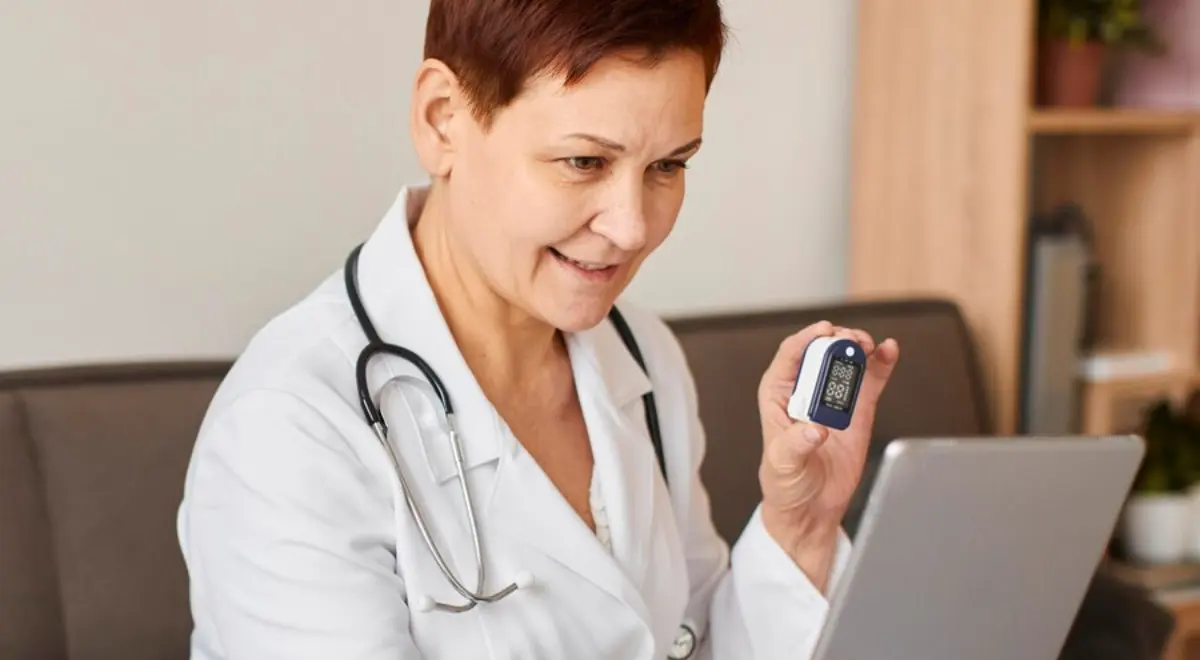The Role of Remote Patient Monitoring in Chronic Disease Management

Chronic diseases are among the major causes of death in the United States with four in ten adults suffering from two or more chronic conditions. Around $4.5 trillion is being spent on chronic disease management annually, and these numbers are rising every year. To bridge gaps in care and reduce healthcare costs, Remote Patient Monitoring (RPM) is playing a significant role.
RPM not only prevents hospital readmissions but also promotes better allocation of resources, using a connected health device that records and reports patients’ daily biometric measurements to their clinicians for diagnostic review and timely intervention.
Remote patient monitoring for chronic disease management improves patients’ health, boosts outcomes, and enhances patient satisfaction. From nurses to physicians and other qualified healthcare providers, RPM acts as a boon that is transforming care coordination and treatment results in chronically ill patients.
In this blog, we have briefly discussed the role played by RPM in ensuring optimal health outcomes in patients with chronic diseases.
- Reduces Hospital Readmissions
A recent research conducted by the Agency for Healthcare Research and Quality (AHRQ) indicated that hospital readmissions cost the US economy a whopping $563 million each year. Readmissions impose a significant burden on both medical facilities and patients with chronic conditions.
Even if the readmissions may be medically justified, patients do suffer physically, emotionally, and financially as a result of readmissions.
The Hospital Readmissions Reduction Program developed under the Affordable Care Act is focused on reducing hospital readmissions. This scheme penalizes hospitals that have readmission rates higher than the national normal 30-day readmission rate of 5.2%.
RPM, along with wearable devices and improved medication has helped hospitals reduce readmissions for congestive heart failure (CHF), COPD, and other chronic diseases. It is also focused on enhancing engagement rate and health outcomes for chronic patients.
As a result, hospitals across the country are implementing innovative RPM solutions to improve post-acute care. Many health insurers are also rolling out RPM programs to provide cover for high-risk patients.
- Promotes Self-care & Self-monitoring
When it comes to chronic disease management, both patients and providers need to play an active role. Patients must actively engage in self-care and self-monitoring to stay aware of any abnormalities in their health vitals. This includes periodic monitoring using RPM devices and health education and guidance by concerned physicians. It allows patients to control their health while lowering down the care costs and improving the quality of life.
The World Health Organization (WHO) defines self-care as the ability to manage, prevent, or address a health issue. This notion includes symptom identification, coping with disability, and managing ill-health signs and symptoms. Various sorts of self-care therapies are widely available that can be performed solely or in combination to ensure optimal health outcomes.
In short, self-care and self-monitoring are two most often ignored components of healthcare, but they actually play a significant role in improving patient care.
- Remote Patient Monitoring Reduces Costs
Remote patient monitoring is a cost-effective way to ensure chronic disease management and helps healthcare providers in making timely diagnosis and avoid unnecessary hospital admissions. Since the majority of patients with chronic diseases require specialized care, RPM allows them to communicate with the best physicians and clinicians in the country via remote patient monitoring platforms providing SMS, audio and video calls functionality.
This type of consultation is not only cost-effective, but saves direct healthcare costs, resources, and even hospital expenditures. Remote monitoring also helps reduce travel costs and effectively optimizing patient engagement and care.
- Improves Overall Patient Satisfaction Rate
As remote patient monitoring makes healthcare more accessible and affordable, it is constantly witnessing increased patient satisfaction, particularly among those with chronic diseases.
A study conducted by The KLAS discovered a 25% reduction in emergency room visits when researching the outcomes of remote monitoring on the health of chronic patients. The report also suggested that patients felt more confident and reassured as a result of remote monitoring.
Researchers also discovered that remote monitoring made patients feel more involved in their care. Patients were urged to take greater responsibility for self-care and their disease management.
Boost Chronic Disease Management Outcomes With HealthArc
With remote patient monitoring playing a significant role in improving patient health and outcomes, the popularity it is gaining is worth the money spent. RPM is not only benefitting the patients and providers, but improving the entire healthcare system.
HealthArc is a leading remote patient monitoring platform helping practices connect to their patients and offers seamless integration with all leading EHRs through HL7 and FHIR capabilities. Healthcare providers can conveniently communicate with patients via audio, video calls, and SMS to make timely interventions.
Schedule a free demo today or call us at (201) 885 5571 to find out how our digital health platform can help providers with chronic disease management and enhance care coordination.
Most recent blogs
Categories
- Advanced Primary Care Management
- Behavioral Health Integration
- Cellular Remote Patient Monitoring
- Chronic Care Management
- Chronic Care Management Billing
- Chronic Care Management CPT Codes
- Chronic Care Management Program
- Chronic Care Management Software
- Digital Health Platform
- Principal Care Management
- Principal Care Management CPT Codes
- Remote Care Programs
- Remote Monitoring Devices
- Remote Patient Care
- Remote Patient Monitoring
- Remote Patient Monitoring Billing
- Remote Patient Monitoring CPT Codes
- Remote Patient Monitoring Devices
- Remote Patient Software
- Remote Therapeutic Monitoring
- Remote Therapeutic Monitoring Billing
- Remote Therapeutic Monitoring CPT Codes
- Telemedicine & RPM
- Transitional Care Management
- Transitional Care Management Billing
- Transitional Care Management CPT Codes
Related Posts
- March 1, 2025 | Read Time: 6 mins
AI in Remote Patient Monitoring: Predictive Analytics, Early Detection, & Personalized Care
- February 25, 2025 | Read Time: 5 mins
Wearable Devices & Their Role in Remote Patient Monitoring
- February 21, 2025 | Read Time: 5 mins






